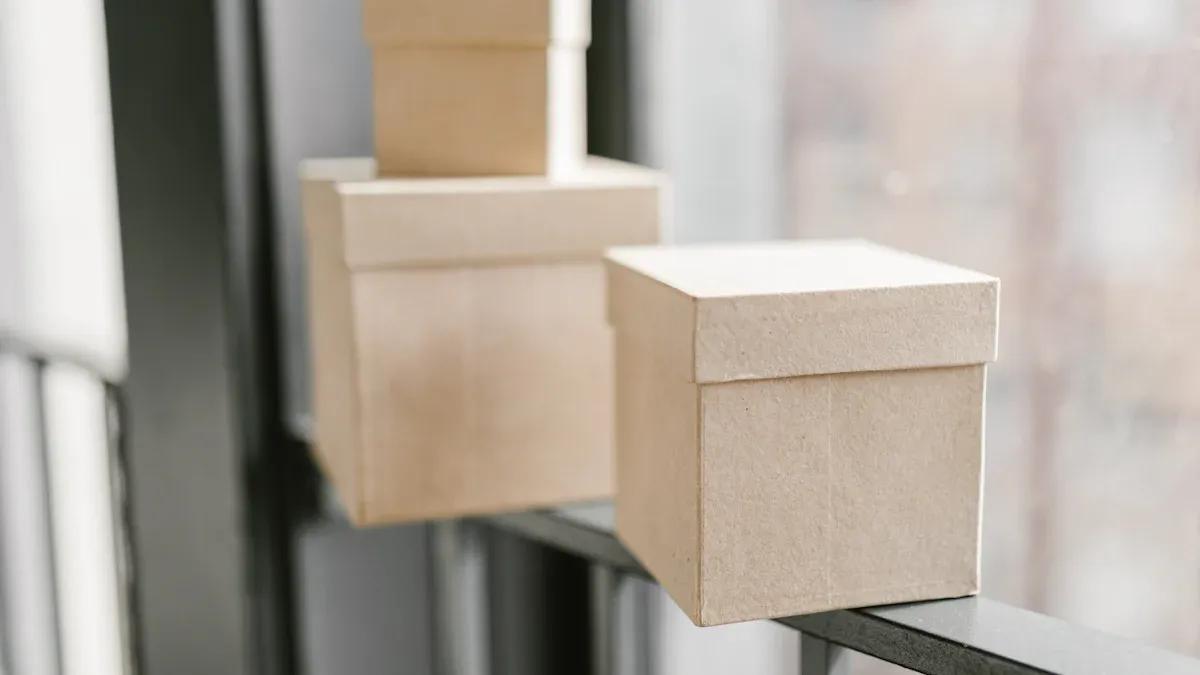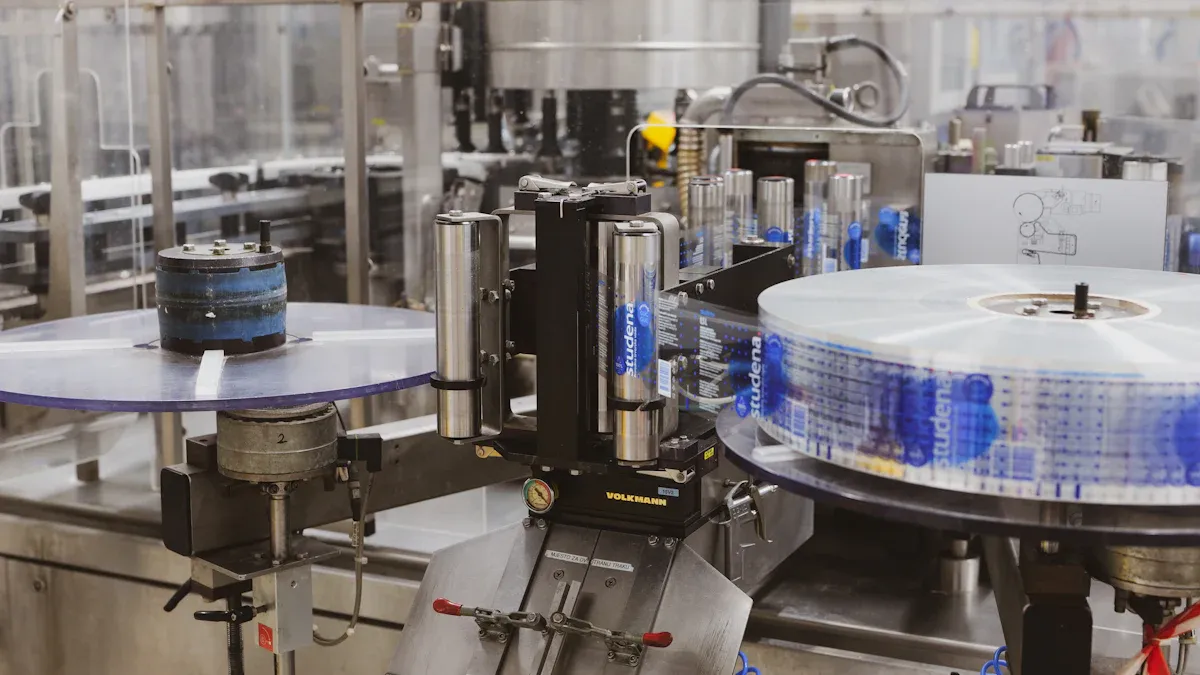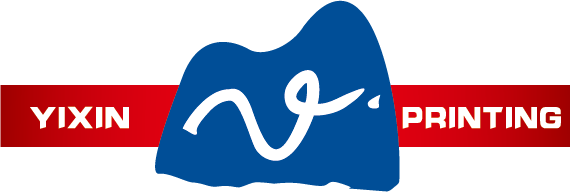
In 2025, robotics and AI have revolutionized how we produce paper boxes. These technologies improve efficiency and precision while reducing waste. I’ve seen how AI-driven systems enhance custom paper box packaging by adapting to unique designs. Robots now handle repetitive tasks faster than ever, ensuring consistent quality and sustainability.
Key Takeaways
Robots and AI make paper box production faster and waste less.
AI quality checks find defects better, making products high-quality and reducing returns.
Automation helps factories adjust to customer needs, allowing more custom orders and growth.
The Role of Robotics and AI in Industrial Automation

Key Trends in Automation for Paper Box Manufacturing
I’ve noticed some exciting trends shaping the future of packaging automation in the paper box industry. Automation is becoming more advanced, with a strong focus on sustainability and efficiency. For example, many manufacturers now use IoT technologies to connect machines and monitor production in real time. This integration allows for smarter decision-making and reduces downtime. Automated machines are also helping companies meet the growing demand for eco-friendly packaging by minimizing waste during production.
Another trend I’ve observed is the rise of robotic packaging systems. These systems are designed to handle complex tasks, such as assembling custom boxes or managing high-speed production lines. They not only improve efficiency but also make it easier to adapt to changing customer needs. Companies like Siemens and Walmart are already leveraging these technologies to transform their manufacturing processes.
AI-Driven Quality Control in Custom Paper Box Packaging
AI has completely changed how we ensure quality in packaging. I’ve seen how AI-powered systems, like those using deep learning and computer vision, can detect defects with incredible accuracy. These systems minimize human error and improve product consistency. For instance, automated defect detection tools can identify flaws in custom paper boxes before they leave the production line. This reduces recalls and saves costs for manufacturers.
Research shows that early adopters of AI in quality control have experienced significant benefits. They’ve reduced operational costs and improved throughput. A table below highlights some key applications and benefits of AI-driven quality control:
Robotics for Enhanced Production Speed and Flexibility
Robots have revolutionized production speed and flexibility in industrial paper automation. I’ve seen how they enable a batch-size-of-one production model, which allows manufacturers to create highly customized boxes without long lead times. This flexibility is crucial for meeting the unique demands of customers.
What’s even more impressive is how robots can adapt to different tasks without needing reconfiguration. This adaptability boosts efficiency and reduces downtime. For example, robotic packaging solutions can switch between assembling small and large boxes seamlessly. This makes automated packaging lines more versatile and productive.
The future of packaging automation looks bright, with robots playing a central role in improving both speed and flexibility. Companies like YiXin Printing are already leading the way by adopting these advanced technologies.
Transforming Manufacturing Processes with Automation
Reducing Costs and Waste Through AI and Robotics
I’ve witnessed how AI and robotics have transformed manufacturing by cutting costs and reducing waste. AI-driven paper processing systems optimize resource allocation, ensuring minimal material waste during production. For example, manufacturers now use predictive analytics to anticipate equipment failures, preventing costly downtime. This proactive approach not only saves money but also extends the lifespan of machinery.
Robotics also plays a key role in reducing labor expenses. Automated packaging lines operate continuously without human intervention, significantly lowering operational costs. I’ve seen companies achieve long-term savings by integrating robotic packaging solutions that streamline production. Additionally, AI helps optimize energy consumption, further reducing expenses. Jaguar Land Rover, for instance, saved over $1.2 million by automating back-office processes, showcasing the financial potential of automation.
Improving Efficiency in Custom Paper Box Packaging
Efficiency is critical in custom paper box packaging, and automation has taken it to new heights. I’ve observed how integrating automation technologies can increase production efficiency by up to 30%. This boost allows manufacturers to meet tight deadlines and adapt to changing customer demands. Automated systems also reduce the need for multiple operators, leading to significant labor savings.
One of the most impressive aspects of packaging automation is its ability to enhance supply chain relationships. By improving operational efficiency, manufacturers can deliver products faster and with greater consistency. This reliability strengthens partnerships with suppliers and end customers. In many cases, companies see a full return on their automation investment within 18 months, making it a smart financial decision.
Real-Time Defect Detection and Predictive Maintenance
Real-time defect detection has revolutionized quality control in manufacturing. AI-powered image recognition systems now identify flaws with remarkable accuracy, ensuring only high-quality products reach customers. A study by Zhang et al. (2021) highlighted how these systems improve product quality and customer satisfaction. I’ve seen firsthand how this technology minimizes recalls and boosts brand reputation.
Predictive maintenance is another game-changer. By analyzing data from IoT devices, AI can foresee equipment failures and schedule timely repairs. Wang et al. (2022) found that this approach reduces unplanned downtime by 30%. Additionally, overall equipment effectiveness improves by 20%, as automated systems maintain peak performance. These advancements not only enhance efficiency but also ensure smoother operations across the production line.
Benefits of Robotics and AI in Paper Box Manufacturing
Enhanced Customization and Scalability
I’ve seen how robotics and AI have unlocked new possibilities for customization and scalability in paper box manufacturing. Robotic packaging systems can now handle a wide variety of box sizes and designs, making it easier to meet unique customer demands. For example, smart systems allow manufacturers to switch between different box types without manual intervention. This flexibility ensures that custom paper box packaging is both efficient and precise.
Scalability has also improved significantly. Robots can adjust production levels quickly to match market demands. This adaptability is crucial for maintaining operational efficiency during peak seasons or unexpected surges in orders. A recent study highlights how robotic systems enable manufacturers to scale up production while maintaining high-quality standards:
Sustainability and Reduced Environmental Impact
Sustainability has become a top priority in manufacturing, and I’ve observed how AI and robotics contribute to greener operations. AI-driven systems optimize resource usage, reducing waste and energy consumption. For instance, modern print techniques powered by AI improve color precision while minimizing ink usage. This not only cuts costs but also supports sustainable packaging practices.
Robots also play a role in reducing environmental impact. Automated packaging lines operate with greater precision, leading to less material waste. Studies show that next-gen high-speed converting equipment reduces waste to less than 2%, compared to 8-10% with conventional systems. Additionally, AI-powered predictive maintenance prevents unexpected breakdowns, saving energy and resources. These advancements make smart paper manufacturing more eco-friendly than ever before.
Increased Productivity and Operational Efficiency
The benefits of robotics and AI extend to productivity and efficiency. I’ve seen how automated packaging lines boost production speeds while maintaining precision. For example, next-gen converting equipment operates at 1200 meters per minute, compared to 500 meters per minute with older systems. This speed increase allows manufacturers to meet tight deadlines without compromising quality.
AI also enhances defect detection and maintenance processes. Machine learning algorithms identify defects early, reducing inspection times by 66%. Predictive maintenance further minimizes downtime, cutting it from 20 hours per month to just 5 hours. These improvements translate to significant cost savings and smoother operations. Here’s a comparison of key metrics before and after AI implementation:
The future of packaging automation looks promising, with robots and AI driving unprecedented levels of productivity and efficiency.
Future Trends in Automation for Paper Box Manufacturing
Smart Factory Integration and IoT Connectivity
I’ve seen how smart factory integration and IoT connectivity are reshaping the future of packaging automation. These technologies allow manufacturers to monitor production in real time, improving efficiency and reducing downtime. For example, IoT sensors collect data from machines to predict maintenance needs before breakdowns occur. This proactive approach saves time and money while ensuring smooth operations.
Digital twins are another exciting development. These virtual models simulate factory processes, helping manufacturers plan automation strategies and visualize complex workflows. Companies like Artesis and Frito-Lay already use IoT for predictive maintenance, cutting costs and boosting efficiency. Supply chain optimization is also benefiting from IoT tools, with 76% of manufacturers planning to adopt digital solutions for better visibility and tracking.
Next-Generation Robotics and AI Systems
Next-generation robotics and AI systems are transforming industrial automation. I’ve noticed how robots now adapt quickly to changing production demands. This flexibility makes it easier to implement small-batch or custom production. Scalable automation solutions also grow with business needs, ensuring long-term efficiency.
AI integration has enhanced the capabilities of manufacturing robots. Machine learning algorithms allow robots to learn from experience, improving their performance over time. For instance, AI-driven predictive maintenance uses sensor data to forecast potential issues, reducing downtime. In the aerospace industry, GE Aviation uses robotic arms for testing, cutting runtime by 20%. Similarly, Samsung’s production lines rely on robots for precise assembly, ensuring speed and accuracy.
Robots now adapt to small-batch and custom production with ease.
AI improves robot decision-making through advanced sensing and learning.
Predictive maintenance minimizes downtime and extends equipment life.
The Impact of Generative AI on Custom Paper Box Packaging
Generative AI is revolutionizing custom paper box packaging by enabling innovative designs and faster production. I’ve seen how AI-powered tools create unique packaging solutions tailored to customer needs. These tools analyze design trends and generate creative ideas, reducing the time spent on manual design processes.
Generative AI also optimizes material usage, supporting sustainable packaging practices. By simulating different designs, manufacturers can identify the most efficient options, minimizing waste. This technology ensures that custom packaging meets both aesthetic and environmental standards. As the future of packaging automation evolves, generative AI will play a key role in delivering smarter, more sustainable solutions.
Robotics and AI have redefined paper box manufacturing, driving smarter and more sustainable production. I’ve seen how advancements like robotic solutions and AI-driven vision technology improve operational efficiency. Mobile robots and preventive maintenance reduce downtime and costs. These innovations pave the way for a future of greater customization and eco-friendly practices.
FAQ
What are the main benefits of using robotics in paper box manufacturing?
Robots improve production speed, reduce errors, and handle repetitive tasks efficiently. They also adapt to custom designs, making manufacturing more flexible and scalable. 🚀
How does AI contribute to sustainability in packaging?
AI optimizes material usage and energy consumption. It reduces waste by improving precision during production. This makes packaging more eco-friendly and cost-effective. 🌱
Can small manufacturers afford automation technologies?
Yes! Automation solutions are becoming more affordable. Scalable systems allow small manufacturers to start small and expand as needed, ensuring cost-effectiveness and gradual adoption. 💡

